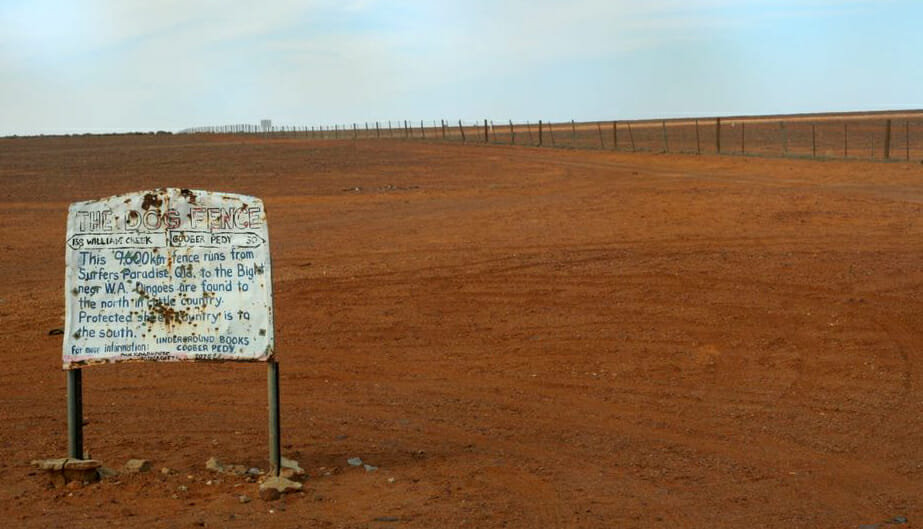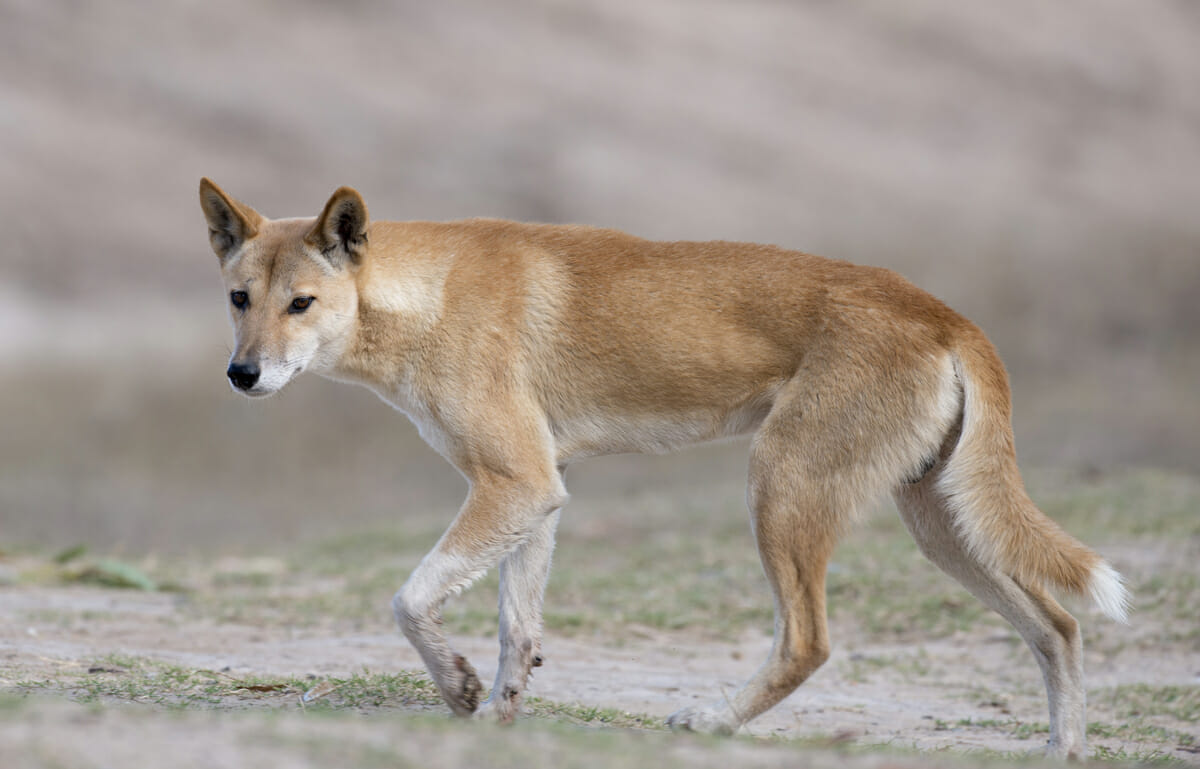Are Dingoes Devouring Australia’s Sheep Industry?
Unique to Australia, this subspecies of the wolf is considered both a pest animal and a national icon, protected on conservation lands and killed in farm country.
Unique to Australia, this subspecies of the wolf is considered both a pest animal and a national icon, protected on conservation lands and killed in farm country.
These polarizing creatures are often seen as a major factor in one of the biggest farming trends Down Under: the evaporation of sheep farms. But is that fair? Are the wild dogs of Australia devastating that country’s wool industry?
Or are they misunderstood scapegoats, taking the blame for an industry suffering from other issues?
One thing is clear: there has been a decline in both sheep numbers and farms over the last 40 years, and many factors are responsible, according to various government reports.
In 1970, sheep peaked in Australia with a population of 180 million. This dropped to 68 million animals by 2009-2010, the lowest numbers since 1905. But the numbers are on the rise, with the latest figures at 74.7 million head. Although there have been reported decreases in sheep and lamb numbers in Queensland and South Australia, they were offset by increases in New South Wales, Victoria and Western Australia.
The number of farmers of all stripes across Australia has been declining for decades, with small farms selling to larger operations and fewer young people taking over family farms – the average age of farmers is 53. In a five-year period, from 2006 to 2011, there was a loss of nearly 20,000 farmers, an 11 percent decrease.
According to a report by the Australian Bureau of Statistics, the main culprit for the collapse in sheep has been “poor market prospects for wool.” Besides the low profitability, other factors for the decline include on-going drought conditions, competition from other farming industries and labor shortages.
According to Lyn Watson, the director of Dingo Discovery Sanctuary and Research Centre in Toolern Vale, Victoria, reported losses of sheep annually hover around 3,600 in Victoria and 1,200 in New South Wales – two large sheep producing states near Queensland. The predation loss is a tiny fraction of livestock loss for these two states that have a total of 55,000,000 sheep. Many more sheep are lost in live export trips, she contends.
But, still, even if a dip in overall numbers of Australian sheep can largely be attributed to economic and climate forces, the dingoes are not helping.

A recent scientific review reported that in Queensland the sheep flock has decreased by 70 percent since the early 1990s, and 40 percent across the rest of the country.
The study, by Ben Allen and Peter West from the Invasive Animals Cooperative Research Centre published in June’s Australian Veterinary Journal, alleged that incursion by dingoes into parts of Queensland, New South Wales, Victoria and South Australia protected by the dingo fence is partly to blame for the decline.
“Dingo predation is by no means the sole cause of the decline in sheep numbers across Australia, but dingoes are a major cause or, at the very least,’the straw that breaks the camel’s back’,” according to the report.
The authors blame a shortage of farm labor, disrepair of fencing and a scattershot approach to wild dog control efforts for the problem.
“History clearly shows that long-term, broadscale control efforts prior to and early in the twentieth century enabled the sheep industry to prosper in the pastoral rangelands through until the peak in sheep numbers in the early 1990s. During those early times, netting fences were extremely common, there was much more labour available and every station-hand controlled wild dogs,” said Allen.
According to Queensland Agriculture Minister John McVeigh, dingoes are public enemy number one. “Wild dogs cost the Queensland grazing industry $60 million a year in lost production and cause untold pain and suffering to farm animals and emotional stress to their owners,” McVeigh said during a speaking engagement in November.
Shepherds tend to agree. Rick Keogh, a Queensland sheep producer, told the Australian Broadcasting Company in May he believed problems with wild dogs were driving others out of the sheep raising business.
Dingoes subsist on a variety of prey, from kangaroos to rats to feral pigs, but will hunt sheep if they encounter them, according to a 2004 University of Nebraska report. Farmers tell of finding their sheep with their livers eaten out, or if found alive, with huge chunks of flesh taken from their haunches, resulting in the animals being put down.
Sheep are particularly vulnerable to dingo attacks. In the face of a wild dogs, they tend to flee or mob. And like the proverbial kid in the candy store, the dogs may rush from animal to animal, inflicting fatal wounds on a number of sheep, whilst only taking one animal for its meal, according to the report.
But for all of the gory mayhem that dingoes wreak, recent studies have pointed to positive roles they can have on the farm. Most notably, an award-winning research team headed up by University of Tasmania Professor Chris Johnson showed dingoes to be “key elements” in the fight to keep down environmental damage caused by foxes, kangaroos and feral cats. “Far from being vermin, Australia’s dingoes sustain biodiversity and can help land managers control invasive species,” according to the research team.
While some say dingoes help keep other problem animals down, Allen and his colleagues disagree. A separate paper, published in July in the journal Frontiers in Zoology, alleged that in areas where wild dogs are eliminated, other predators, such as foxes and feral cats, don’t replace them.
“It just doesn’t happen,” Allen said in a media release.
How To Kill a Dingo
Dingoes, and wild dogs in general, are considered vermin by many state governments and as such, its populations are controlled in sheep, goat and cattle grazing areas. The major weapon used in controlling the wild dog population is sodium fluoroacetate, known as 1080, a poison that dingoes and domesticated dogs are highly susceptible to.
In Queensland, the government is loosening restrictions on the use of 1080 to “give graziers more options to undertake baiting programs,” in the words of McVeigh, the agriculture minister. Another recent study, this one on the effects of baiting with 1080, purports to show that instead of decreasing predation by wild dogs, baiting actually increases the loss of livestock by disrupting their pack structure.
According to a study by Dr. Lee Allen, a zoologist with Biosecurity Queensland, when the pack structure is changed, younger, less experienced dogs will go after livestock rather than its usual prey of kangaroos, rabbits and other small animals because the young dingoes don’t have the hunting experience to handle larger prey. “They’re then left with the problem of how to feed themselves and it’s basically getting a whole bunch of young teenagers together and they get up to all sorts of strife,” he told the Australian Broadcasting Company in a March interview.
Watson said there are better ways to deal with wild dog situation than baiting and at a much lower cost to the “public purse” and the environment, including compensating farmers for losses and using “proven protective measures such as donkeys, llamas, camels, flock guardian dogs and exclusion fencing.”
Follow us

This work is licensed under a Creative Commons Attribution-NoDerivatives 4.0 International License.
Want to republish a Modern Farmer story?
We are happy for Modern Farmer stories to be shared, and encourage you to republish our articles for your audience. When doing so, we ask that you follow these guidelines:
Please credit us and our writers
For the author byline, please use “Author Name, Modern Farmer.” At the top of our stories, if on the web, please include this text and link: “This story was originally published by Modern Farmer.”
Please make sure to include a link back to either our home page or the article URL.
At the bottom of the story, please include the following text:
“Modern Farmer is a nonprofit initiative dedicated to raising awareness and catalyzing action at the intersection of food, agriculture, and society. Read more at <link>Modern Farmer</link>.”
Use our widget
We’d like to be able to track our stories, so we ask that if you republish our content, you do so using our widget (located on the left hand side of the article). The HTML code has a built-in tracker that tells us the data and domain where the story was published, as well as view counts.
Check the image requirements
It’s your responsibility to confirm you're licensed to republish images in our articles. Some images, such as those from commercial providers, don't allow their images to be republished without permission or payment. Copyright terms are generally listed in the image caption and attribution. You are welcome to omit our images or substitute with your own. Charts and interactive graphics follow the same rules.
Don’t change too much. Or, ask us first.
Articles must be republished in their entirety. It’s okay to change references to time (“today” to “yesterday”) or location (“Iowa City, IA” to “here”). But please keep everything else the same.
If you feel strongly that a more material edit needs to be made, get in touch with us at [email protected]. We’re happy to discuss it with the original author, but we must have prior approval for changes before publication.
Special cases
Extracts. You may run the first few lines or paragraphs of the article and then say: “Read the full article at Modern Farmer” with a link back to the original article.
Quotes. You may quote authors provided you include a link back to the article URL.
Translations. These require writer approval. To inquire about translation of a Modern Farmer article, contact us at [email protected]
Signed consent / copyright release forms. These are not required, provided you are following these guidelines.
Print. Articles can be republished in print under these same rules, with the exception that you do not need to include the links.
Tag us
When sharing the story on social media, please tag us using the following: - Twitter (@ModFarm) - Facebook (@ModernFarmerMedia) - Instagram (@modfarm)
Use our content respectfully
Modern Farmer is a nonprofit and as such we share our content for free and in good faith in order to reach new audiences. Respectfully,
No selling ads against our stories. It’s okay to put our stories on pages with ads.
Don’t republish our material wholesale, or automatically; you need to select stories to be republished individually.
You have no rights to sell, license, syndicate, or otherwise represent yourself as the authorized owner of our material to any third parties. This means that you cannot actively publish or submit our work for syndication to third party platforms or apps like Apple News or Google News. We understand that publishers cannot fully control when certain third parties automatically summarize or crawl content from publishers’ own sites.
Keep in touch
We want to hear from you if you love Modern Farmer content, have a collaboration idea, or anything else to share. As a nonprofit outlet, we work in service of our community and are always open to comments, feedback, and ideas. Contact us at [email protected].by Andrew Amelinckx, Modern Farmer
December 10, 2013
Modern Farmer Weekly
Solutions Hub
Innovations, ideas and inspiration. Actionable solutions for a resilient food system.
ExploreExplore other topics
Share With Us
We want to hear from Modern Farmer readers who have thoughtful commentary, actionable solutions, or helpful ideas to share.
SubmitNecessary cookies are absolutely essential for the website to function properly. This category only includes cookies that ensures basic functionalities and security features of the website. These cookies do not store any personal information.
Any cookies that may not be particularly necessary for the website to function and are used specifically to collect user personal data via analytics, ads, other embedded contents are termed as non-necessary cookies.
